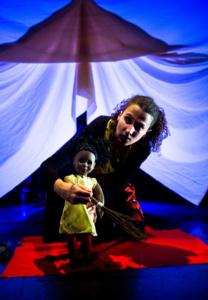When entering the small theatre at the French Institute spectators were informed that today the show was being filmed and to behave as normal. It would appear by the guest’s reactions that ‘normal’ for such a show was demonstrating emotional turmoil. After the show there were people unable to move who told people walking past them that they just had to get ‘themselves together’. This show did not fail to connect to the audience on every level it could, portraying the subject of refugees. It presented us with a roller coaster of feelings.

Gael Le Cornec’s show has been inspired by stories from real refugees. She acts out the story of little ‘Mana’ in such a way that we can only watch and absorb the sheer emotion of this girl who hopes for a better life. Mana is close to her Grandmother in a war-torn planet. Her Grandmother tells her stories including a preparation to leave the red and yellow planet, which is defined by blood and mud and arriving on the blue planet, where life is assumed to be better. Mana goes on an unsympathetic journey leaving behind her home and using all her efforts to get to the blue planet.
We follow Mana on this journey full of different characters and hardships. There is a great use of props and lighting allowing us to see various perspectives of Mana’s situation. She is a brave girl who becomes confronted with terrible scenarios including genocide, trafficking and cruel individuals who wish to hurt her. Such difficult subjects are represented by other means such as fictional characters, pumpkin heads and cut outs. Such are manipulated and portrayed with real sentiment and accuracy. We feel curious about how the next scene may unfold.
Despite Mana’s numerous deceptions she rarely loses her optimism that she can indeed reach the blue planet. She is full of hope and is also assertive on one occasion standing up to the pumpkin head. There is a particular eerie scene when there is a carriage full of dolls representing the dead children. Mana chooses a doll, which she nurtures in a similar way to which she has been nurtured by her own Grandmother. The doll means everything to her. Maybe it is a companion, her inner child or another version of her. When eventually Mana reaches the blue planet and has to part with the doll we see the actress displaying strong and desperate emotions. This separation is too much for Mana. The doll has become part of her.
This play is particularly relevant today as it is not possible to ignore the endless mediatized stories surrounding refugees from various countries. A real virtue of the play is it’s access – we could relate it to any refugee from any country. Each female in Mana’s situation is trying to accomplish the same goals but is met with obstacles. Even when she makes it to the blue planet we understand that Mana is only recognized as a number. Mana is desperate to recount her story to the authorities but is met with indifference and even hostility. Towards the end of the play we enter into the roller coaster of feelings and feel helpless to Mana’s predicament. The show informs, recognizes and encourages awareness of today’s refugee crisis. It is excellently presented with displayed statistics bringing home just how serious the problem is for children in this dreadful position.
The Other Preview audience from Gaël Le Cornec
- CRYPTO-CURRENCY Addiction on the Rise - 21st November 2018
- The Cry (TV Mini-Series 2018– ) - 24th October 2018
- Swimming with Men (2018) - 2nd July 2018











Reading this review I want to see this play it feels it is very well done, and it will be hard hitting , however I feel it a must.